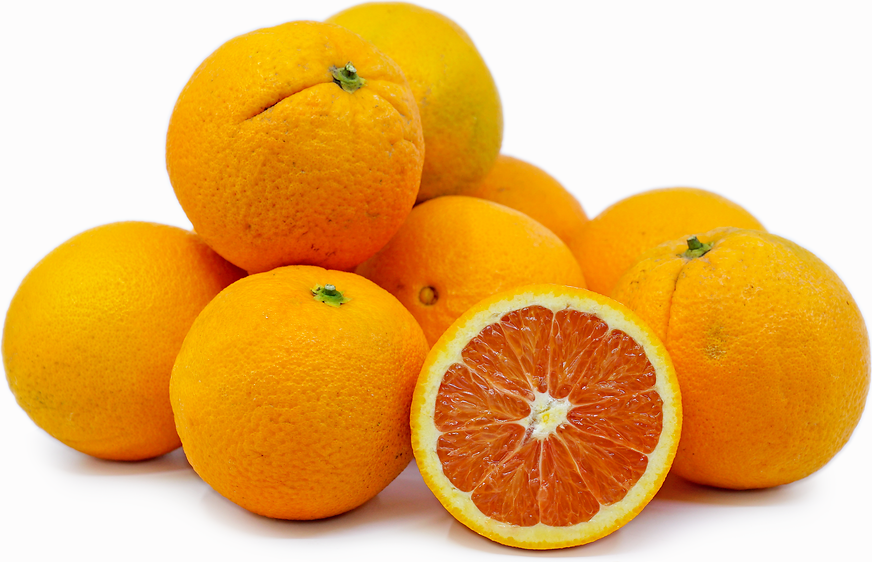


Cara Cara Oranges
Estimated Inventory, lb : 0
Description/Taste
Extraordinary Cara Cara oranges boast a vivid and rich deep salmon color. Offering succulent flavor, the gorgeous and sweet flesh is low acid and seedless. Some describe the flavor reminiscent to a perfect blend of tangerine and grapefruit. Size varies from small and medium to large.
Seasons/Availability
Look for Cara Cara oranges beginning in January. The season of this special orange sweetie ends around the end of May.
Current Facts
Cara Cara oranges, botanically classified as Citrus sinensis, are commonly refereed to as "the pink navel". Cara Cara oranges are the result of a natural mutation discovered on a Washington navel orange tree. The Cara Cara orange tree exhibits many similar characteristics to the Washington navel orange tree, with exception to occasionally producing striped leaves and twigs that if are left to fruit may produce oranges with variegated rinds. The deep pink flesh of the Cara Cara orange is from the presence of a caroteniod, lycopene.
Nutritional Value
An excellent source of vitamin C, oranges provide dietary fiber and are sodium-free. Oranges, along with other citrus, contain carotenoids, flavenoids, and coumarins that are considered powerful anticarcinogens. The antioxidants, glutathione and glucarate, are also present. The Cara Cara orange contains lycopene, which gives the red color to its pulp. This natural pigment, through research, has been shown to fight against certain diseases.
Applications
Cara cara oranges are and ideal balance of sweetness and acidity, making them suitable for eating fresh, jams, sauces, baking and sauteing. Use in savory or sweet preparations, paired with avocados, lettuces, fresh herbs, strong cheeses, fresh fruit, whole grains, and poultry. Use cara cara juice in curds, cocktails, vinaigrette and syrups. Cara cara oranges will keep up to two weeks, refrigerated.
Ethnic/Cultural Info
The name orange actually refers to the fruit's scent, not its color. The word comes from the Sanskrit word "naranga", which comes from the Tamil word "naru", meaning fragrant. An old variety, the Brazilian type of navel orange is properly called "Bahia."
Geography/History
This orange originated at the Hacienda Cara Cara in Venezuela in 1976, hence its name. In 1870, the United States Department of Agriculture in Washington, D.C. sponsored the first introduction of navel oranges to the United States, and of course, the fruits were called Washington Navel. In 1873, three branches of an orange variety from Brazil were given to Eliza Tibbets by an official of the United States Department of Agriculture. By 1878, she had three fruit-bearing trees and had begun the navel orange industry in Riverside, California. Today delicious descendants of the Washington navel orange are being enjoyed. Amazingly, one of those three original trees is still alive and still bearing fruit. The word "navel" comes from the development of a secondary fruit at the end of the main fruit which causes a belly-button look.Locally grown at Fallbrook, California, at Garcia Organic Farms, owner and grower Armando Garcia was one of the first farmers to cultivate Cara Cara orange about 10 years ago. Three weeks before the Cara Cara oranges are ready for harvest, Garcia Organic Farms stops watering the trees in order for the nurturing rays of the sun to develop optimum flavor in the fruit. Watering during this final stage of growth would water down the Cara Cara orange's great flavor. Proud of providing premium produce to the marketplace, family-owned Garcia Organic Farms is reputed for researching and growing newly released cultivars and for being one of the first to supply the market with exciting and diverse varieties. Armando's father assists in the agricultural research and gathers vital information to keep Garcia Organic Farms on the forefront of successful farming procedures. Garcia Organic Farms has been providing the marketplace with outstanding fruit since 1985. Two farming locations, more than one hundred varieties of premium quality fruit are produced on thirty acres of rich, fertile land. Specialty Produce promotes and endorses our local growers and the California farming industry.
Recipe Ideas
Recipes that include Cara Cara Oranges. One
Podcast




